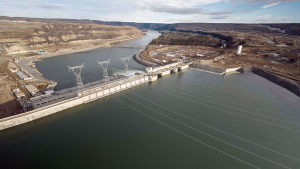With federal economic stimulus money flowing to municipalities for infrastructure projects, work crews are looking to bypass a cracked sewage pipe that services three quarters of a million residents and an untold number of businesses across much of Toronto.
With federal economic stimulus money flowing to municipalities for infrastructure projects, work crews are looking to bypass a cracked sewage pipe that services three quarters of a million residents and an untold number of businesses across much of Toronto.
The Coxwell Sanitary Trunk Sewer runs 4.8 kilometres from the top of Coxwell Avenue in the Don Valley to the Ashbridges Bay wastewater treatment plant at Lake Ontario. Investigations reveal significant deterioration and cracking along a 60-metre stretch, just north of O’Connor Drive, along Barbara Crescent.
An overriding concern is that the Coxwell sewer has no redundancy to allow for rerouting of flows. This means any collapse or blockage could cause it to back up and empty into the Don River.
That’s bad news given that the sewer collects one-third of the city’s sewage from a swath of smaller tributaries across the northern middle section of Toronto. But Lou Di Gironimo, general manager of Toronto Water, says the concrete pipe and steel casing appear to be holding well.
Di Gironimo says much of the preparatory work has already been completed, including geotechnical studies to confirm the routing and location of a planned permanent bypass.
“We’re ready to qualify design-build teams, and once we have a shortlist of qualified consortia we’ll issue a request for proposals.”
The feds will cover one-third of the projected $40 million cost, and the municipality will pay the balance.
The Coxwell sewer is the costliest of all the projects Toronto is undertaking through the federal Infrastructure Stimulus Fund, and the job will have its fair share of challenges. With deteriorated areas as much as 40 metres beneath the surface, crews plan to dig shafts and tunnel their way to the pipe.
The powerful, unrelenting nature of the flow through the gravity-based pipe will dictate the nature of the project. The pipe can’t be shut down or emptied on its own, so workers will build a bypass and then connect it rather than repairing the existing pipe.
“It’s too dangerous to send anyone inside,” Di Gironimo says, adding that workers used robotics to investigate its condition in the first place.
The old pipe may serve as a backup if it is found to be repairable when the bypass is in place. “Essentially we’re twinning a short section of this sewer,” Di Gironimo explains.
The project needs to be substantially completed by March 31, 2011 to receive the federal funding, and work could begin this winter.
Di Gironimo says the city hopes to name a successful design-build firm before year’s end. “If we have all the bid documents in place we could start in January.”
Graeme Clark, interim executive director of the Ontario Sewer and Watermain Construction Association, says any work of this magnitude stands to benefit not only the contractors who are directly involved but suppliers and other parties, as well.
“I would certainly expect that there would be 40 to 50 employees full-time on a job like that,” Clark says, adding that actual numbers could vary depending on factors such as the timing and duration of the project’s various components, and actual plans and tender specifications.
Clark says the pipe has been in the ground a long time and repairs are long overdue. “It’s well past its best-before date, and it’s indicative of a lot of the other infrastructure that needs replacing.”










Recent Comments
comments for this post are closed